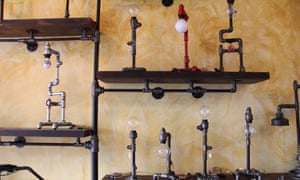
TheGuardian, by John Brunton – Despite being in a conflict zone, Beirut is somehow rising like a
phoenix from the ashes. The past 12 months have seen the reopening of
the Sursock Museum,
a contemporary art gallery supervised by renowned French architect
Jean-Michel Wilmotte, and the inauguration of Aishti, a cutting-edge art
foundation that rivals the Punta della Dogana in Venice. In September,
the doors will open to Beit Beirut (beitbeirut.org), a museum and arts centre dedicated to the memory of decades of conflict.
It’s housed in an imposing neo-Ottoman villa on the former “green
line” between Muslim and Christian Beirut and served as a sniper bunker
during the civil war. Its crumbling, half-destroyed state has been
deliberately preserved, complete with bullet holes and shell pockmarks.
Youssef Haidar, the architect of the project, says: “The new museum will
hopefully be a step towards replacing the mass amnesia here for what
has happened in the past, so that we can come to terms with our
uncertain, but promising and wishful future.”
These new museums are just a small part of what is happening in the
Lebanese capital. While the guidebooks talk up luxury hotels and haute
couture in the restored downtown area, a host of bars and restaurants,
local designer boutiques and art galleries are popping up in the more
bohemian neighbourhoods of Mar Mikhael, Badaro and Gemmayzeh.
The dining room of Liza Soughayar’s restaurant
in the Ashraf?eh district is hung with paintings of bombed Beirut
buildings by a young Lebanese artist. Liza, who had found culinary fame
in Paris, says she could not resist being part of the renaissance in her
home town. “It has not been easy opening Liza in Beirut,” she says,
“but there is an incredible drive to create and succeed here, because
life is so tough that people simply have to make things happen all the
time.”
At dusk, as happy hour kicks in, Armenian Street in Mar Mikhael comes to life, with dozens of bars – including Locale, Anise,
one called Under Construction and the retro Internazionale – packed
until the early hours. As the bartender in Anise pours an absinthe or
iced vodka infused with za’atar and sumac, it is difficult to believe
that until recently most of these places used to be run-down garages.
Badaro, a quiet quarter that suddenly became a hotspot, is now all design boutiques: Pipe Brothers sells lamps and other housewares made from recycled pipes, and Mastike is full of retro collectibles. At the brand new Kissproof cafe, the crowded pavement terrace and bearded barmen are more Barcelona than Beirut.

When the Beit Museum officially opens in September, the guest of
honour will be Anne Hidalgo, the high-profile mayor of Paris, a city
coming to terms with the effects of terror attacks.
Soughayar says: “The Paris mayor will discover a city that has
learned to survive by living with its past while always looking to the
future.”



